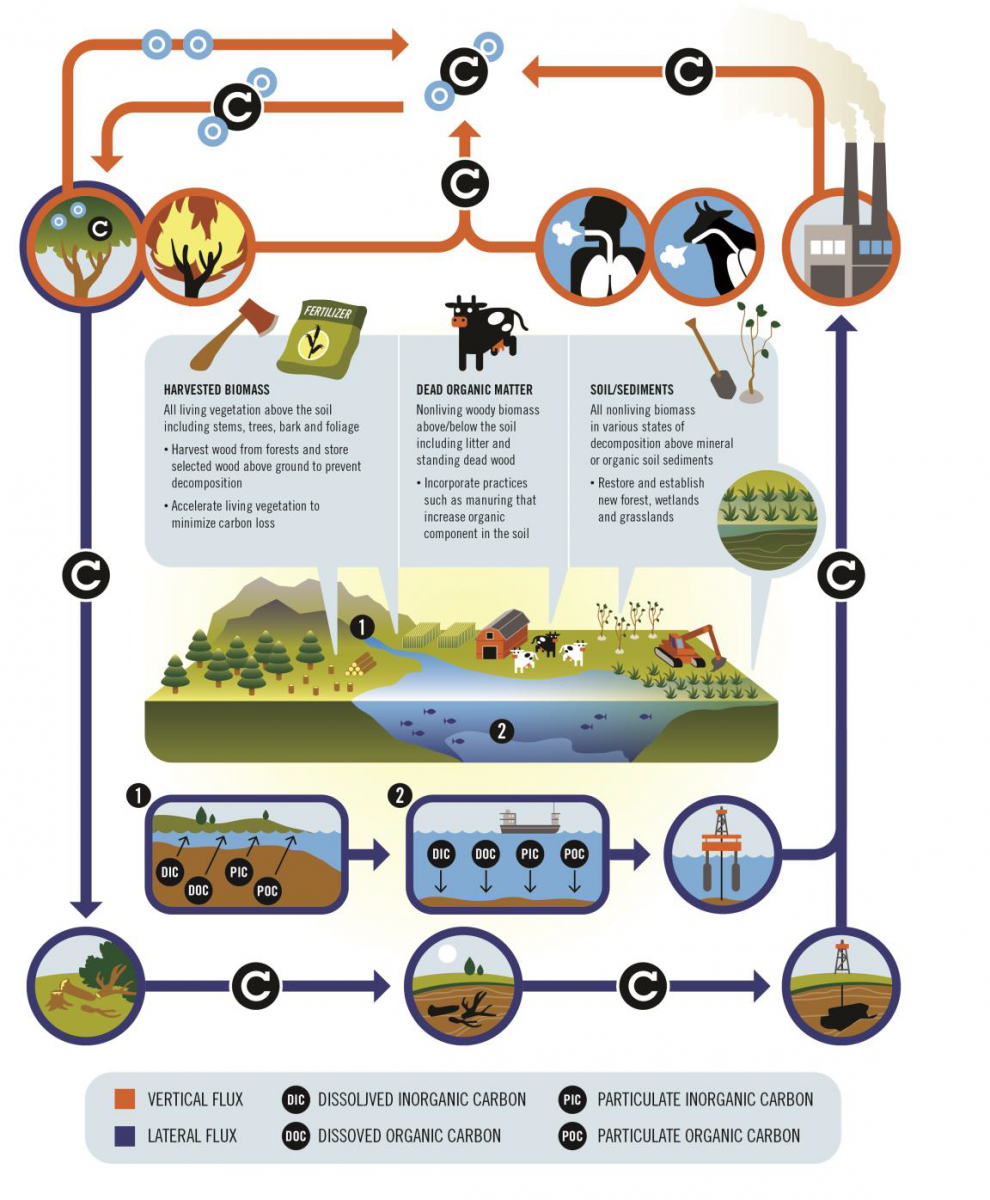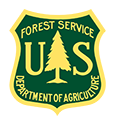White House Priority Agenda on Enhancing Climate Resilience
The White House Priority Agenda on enhancing climate resilience and the associated Fact Sheet have just been released.

Pages 25 and 38 contain information on US Carbon Cycle Science Program/CCIWG activities (namely the 2013 NASA ROSES call, the Carbon Monitoring System Awards and the North American Coastal Carbon Synthesis). The content on/related to other USGCRP components/National Climate Assessment can also be found throughout this document. '...This Agenda identifies the following four priority strategies to make the Nation’s natural resources more resilient to a changing climate. For each strategy, the Agenda documents significant progress and provides a roadmap for action moving forward.' Highlights of the key actions federal agencies will undertake in the near term to implement each of the four strategies are provided in the Agenda:
- Foster climate-resilient lands and waters
- Manage and enhance U.S. carbon sinks
- Enhance community preparedness and resilience by utilizing and sustaining natural resources
- Modernize Federal programs, investments, and delivery of services to build resilience and enhance sequestration of biological carbon
The White House Press Release is below.
EXECUTIVE OFFICE OF THE PRESIDENT
COUNCIL ON ENVIRONMENTAL QUALITY
WASHINGTON, D.C. 20503
FOR IMMEDIATE RELEASE:
October 8, 2014
FACT SHEET: Building community resilience by strengthening America’s natural resources and supporting green infrastructure
President Obama has made it clear that we have a moral obligation to our children and future generations to leave behind a planet that is not polluted and damaged. That is why, as part of his effort to combat climate change, the President launched a Climate Action Plan last year to cut carbon pollution, prepare communities for the impacts of climate change, and lead international efforts to address this global challenge.
The Climate Action Plan recognizes that even as we act to curb the carbon pollution that is driving climate change, we must also improve our ability to prepare for the climate impacts we are already seeing across the country. States, cities, and communities depend on America’s bountiful natural resources, and climate change is putting many of these vital resources at risk. By investing in smart strategies for conserving and restoring our lands and waters, we can help make communities more resilient to climate impacts while slowing the harmful effects of carbon pollution. Similarly, investments in green infrastructure can help communities better prepare for the impacts of climate change while also improving water quality and community health.
That’s why today, the Administration is announcing new executive actions and a series of private and public sector commitments that will improve the management of our natural resources in the context of a changing climate and support investment in green infrastructure.
Enhancing the resilience of America's natural resources and the communities that depend on them
Today, as called for in the President's Climate Action Plan, the Administration is announcing a Climate and Natural Resources Priority Agenda that represents a first of its kind, comprehensive commitment across the Federal Government to support resilience of our natural resources. It identifies a suite of actions the Federal Government will take to enhance the resilience of America's natural resources to the impacts of climate change and promote their ability to absorb carbon dioxide. The agenda, which was called for in the President's Executive Order on Climate Preparedness, was developed jointly by Federal agencies and is informed by the President's State, Local, and Tribal Leaders Task Force on Climate Preparedness and Resilience and other stakeholder engagement.
The actions outlined in the agenda focus on protecting important landscapes and developing new science, planning and tools to foster climate-resilient lands and waters; enhancing U.S. carbon sinks such as forests, grasslands, wetlands and coastal areas; promoting innovative 21st century infrastructure that integrates natural systems into community development, including green storm water infrastructure; and modernizing Federal programs, investments, and services to build resilience and enhance carbon storage. For a full list of the actions Federal agencies will take, including timelines, click here.
To complement the agenda, the Administration is announcing new executive actions and a series of private, public, and nonprofit sector commitments that support resilient natural resources and the communities that depend on them.
New executive actions to support resilient natural systems:
A New Model for Climate Coastal Vulnerability Assessments: The U.S. Army Corps of Engineers (USACE) is releasing the results of its screening-level vulnerability assessments for coastal projects, which find that roughly one third of USACE coastal projects are vulnerable to climate change. These assessments can be used as a model for other agencies when screening vulnerability.
Rapid Assessment Tools for Carbon Sequestration Potentials: USACE is announcing the first rapid, quantitative estimates of existing carbon sequestration and sequestration potentials on the more than 20 million acres of land and water it manages. These areas include reservoirs with potential to sequester large amounts of carbon per unit area.
Tall Wood Competition: In an effort to support sustainable forestry, reduce greenhouse gas emissions, and increase opportunities for rural America, the Department of Agriculture will launch the U.S. Tall Wood Building Competition to design and demonstrate high-rise building construction using innovative wood products. Selected teams of architects, engineers, and developers will receive funding to support incremental costs of pioneering wood construction techniques to address engineering and code variance needs.
$23.8 Million in projects to build resilient coastal communities: Through its Sea Grant Program, NOAA will provide $15.9 million to support over 300 projects around the nation that help build resilient coastal communities and economies. Through university, state and other partnerships, Sea Grant will supplement the Federal funding with an additional $7.9 million in non-federal matching funds, bringing the total investment to more than $23.8 million.
Coastal Salt Marsh Restoration: Yesterday in Cape May, New Jersey, Secretary of the Interior Sally Jewell announced a $1.9 million agreement between the U.S. Fish and Wildlife Service and the American Littoral Society to restore 1.5 miles of shoreline at Reed Beach, part of a $15 million investment to restore coastal salt marshes in New Jersey. In addition to flood control benefits, salt marshes are vital wildlife habitat serving as a nursery for 75 percent of commercially harvested fish.
Private and public commitments to support resilient natural systems:
Targeting blue carbon: To better understand how oceans and coastal ecosystems store and sequester carbon – so-called “blue carbon,” – Restore America’s Estuaries is launching a new assessment of coastal blue carbon opportunities in Tampa Bay, Florida. The study will be funded by the Tampa Bay Environmental Restoration Fund, with additional support from NOAA and DOI.
Restoring Galveston Bay estuary: The Galveston Bay Foundation, Restore America’s Estuaries, and Accenture are initiating a new partnership to advance estuary restoration in Galveston Bay and reduce greenhouse gases. The project will result in more than 30 acres of salt marsh restoration, a new private investment framework to support Galveston Bay restoration and conservation, advance climate adaptation strategies, and support green jobs and skills training.
Creating a mapping tool for forest carbon: To maximize the carbon impact of forest conservation in local communities, the Trust for Public Land will develop a new mapping tool on the Esri platform to help local governments, land trusts, and other community-based users identify forest properties with high carbon stocks and assess the strategic value of these properties for climate resilience, such as protecting public drinking water supplies.
Investing in wood products: The Binational Softwood Lumber Council and the Softwood Lumber Board projects that the softwood lumber industry will invest $20 million over the next two years in programs that utilize wood as a lower carbon-footprint building material. To give a sense of what that can mean for carbon storage, this year, the softwood lumber industry invested nearly $10 million to fund programs that support the shift from carbon-intensive building products like steel and concrete to wood products, resulting in an estimated 131,000 metric tons of additional stored carbon and 280,000 metric tons of avoided carbon emissions according to lifecycle analysis by the wood products industry.
Engaging family forest owners: The American Forest Foundation (AFF) is announcing a $10 million, five year campaign funded by a diverse public private partnership including individual donors, private foundations, and Federal and state government to reach and engage a quarter of a million of America’s family and individual forest owners. Through this effort, AFF will train and support family and individual landowners in promoting climate friendly stewardship of their forests, many of which are located in the highest priority carbon landscapes in the country.
Investing in natural infrastructure: Through its Resilient Landscapes Initiative, the Open Space Institute (OSI) will invest $10.7 million and leverage as much as $53.5 million over the next 2.5 years to conserve land through purchase and easements in as many as 14 eastern states, from Maine to Alabama. Applying science developed by the Nature Conservancy, OSI will identify for its investments lands that are likely to facilitate wildlife adaptation to climate change, and reduce the potential risk of flooding and drought.
Informing Conservation Planning: The Open Space Institute is announcing $95,000 in grants to four northeastern organizations to integrate climate science into conservation planning. Additionally, in partnership with the U.S. Fish and Wildlife Service’s Northeast Landscape Conservation Cooperative, OSI will invest $100,000 in developing and disseminating climate science through a series of guidance documents and tools for local officials.
Engaging communities to grow urban forests: To improve the health and resilience of urban communities through service, the Alliance for Community Trees is committing to engage over 26,000 volunteers to plant more than 50,000 trees in the month of October for National NeighborWoods Month. In addition, American Forests will assist six cities – Austin, Chicago, Hartford, Miami, Oakland and Washington D.C. – to assess the impact of climate and other factors on each city’s urban forest, educate the public on the role of urban forests in improving community resilience, and strategically plant trees to mediate the heat-island effect and sequester carbon.
Restoring damaged forest areas: Arbor Day Foundation will plant an additional 20 million trees to improve the health and resilience of public forest lands by July 1, 2019. The Foundation focuses on restoring trees and enhancing climate resilience in areas of national and state forests damaged by insects, disease, and wildfires.
Delivering trees to reduce energy use: Through its Energy-Saving Trees program, by July 1, 2015, Arbor Day Foundation will deliver more than 140,000 trees to utility customers. According to the program, these trees will reduce customers’ summer air-conditioning energy consumption by as much as 20% as the trees mature. By 2025, these trees will reduce energy consumption by as much as 264 million kilowatt-hours and accomplish as much as 391,000 metric tons of carbon dioxide sequestration and avoided emissions.
Launching an Urban Conservation Initiative: The Nature Conservancy and the Center for Whole Communities are launching a partnership to build a network of 13 cities to help address the impacts of climate change and improve environmental health in urban areas through focusing technical assistance on the use of natural infrastructure. Work will be focused on coastal and flood resilience, urban forests, water source protection, and environmental leadership.
Supporting coastal resilience: The Nature Conservancy will expand its coastal resilience tools and assistance program to Virginia, California, North Carolina, and Baja California in Mexico to help planners, businesses, and officials make decisions that utilize natural systems as adaptation solutions to improve climate resilience.
Expanding a Coastal Resilience App: The Nature Conservancy, with its partners, is expanding the deployment of its award-winning app, Coastal Defense, which helps decision makers identify areas at risk of coastal erosion and inundation from wave action and storm surge and determine appropriate strategies for utilizing natural and built systems to improve resilience. New regions to use the app include South Florida, New Jersey, North Carolina, Virginia, the Caribbean, and sites in the Gulf of Mexico.
Reducing flood risk in Puget Sound: The Nature Conservancy, Puget Sound Partnership, and the Washington Department of Ecology are accelerating actions within their Floodplains by Design partnership to restore habitat and reduce flood risk in Puget Sound's major river corridors. As part of this effort, a new agreement with CH2M Hill, with funding from the Boeing Company, will measure the benefits of natural infrastructure design.
Investing in Climate Adaptation: The Wildlife Conservation Society’s Climate Adaptation Fund, with support from the Doris Duke Charitable Foundation, is announcing the award of $2.5 million to support 13 on-the-ground adaptation actions specifically designed to increase the resilience and adaptive capacity of terrestrial, freshwater and coastal ecosystems across the United States. Non-profit grantees will leverage an additional $2.5 million in private and public support for science-based projects that anticipate and respond to potential climate change impacts, while yielding sustainable, long-term conservation outcomes.
Restoring forests in the Lower Mississippi Delta: With support from the Walton Family Foundation and the McKnight Foundation, the Trust for Public Land will deliver outreach and technical assistance to private landowners interested in restoring carbon-rich bottomland forest to flood-prone agricultural lands in the Lower Mississippi Delta. This announcement puts the Trust on track to meet its target to achieve an additional 3,750 acres of Lower Mississippi private lands reforestation and permanently conserve 3,200 acres of bottomland forest over the next two years, leading to more than 2.1 million tons of CO2 sequestration and storage (the equivalent of taking 442,000 cars off the road for one year).
Advancing green infrastructure to improve community resilience
At a July meeting of the President’s State, Local and Tribal Leaders Task Force on Climate Change Preparedness and Resilience, the Administration announced the Green Infrastructure Collaborative, in which seven Federal agencies committed to expanding the use of green infrastructure techniques such as rain gardens, permeable pavements, rain water harvesting, land conservation and wetland protection to improve natural management of stormwater. The Administration reaffirmed its commitment to implement this initiative, along with additional stormwater management assistance, in the Climate Natural Resources Priority Agenda released today.
Additionally, today, 26 public and private sector organizations announced they are joining the Administration’s Green Infrastructure Collaborative. Through activities including research, outreach, information-sharing, tool development, and technical assistance, the new members are committing to work towards improving stormwater management and expanding the use of green infrastructure techniques in communities across the country. These new members of the Collaborative represent the private, public, and nonprofit sectors, ranging from environmental organizations to academic institutions and professional associations to utilities and municipalities.
Through the Collaborative, all member organizations have pledged to work together to highlight the broad community benefits of green infrastructure including improving air quality, reducing energy use, mitigating climate change, and increasing resilience to climate change impacts. The organizations joining the Green Infrastructure Collaborative today are:
American Rivers
American Society of Civil Engineers
American Society of Landscape Architects
Amigos De Los Rios
American Public Transit Association
Association of Clean Water Administrators
The Center for Neighborhood Technology
The Conservation Fund
Environmental Defense Fund
The Green Infrastructure Center
Institute for Sustainable Infrastructure
International Association of Plumbing and Mechanical Officials
Low Impact Development Center
Mid-Atlantic Green Infrastructure Consortium
National Association of Clean Water Agencies
National Association of Development Organizations Research Foundation
National Association of Flood & Stormwater Management Agencies
National Recreation and Park Association
Natural Resources Defense Council
TreePeople
Trust for Public Land
U.S. Water Alliance
University of New Hampshire Stormwater Center
Water Environment Federation
Willamette Partnership
World Resources Institute
###




